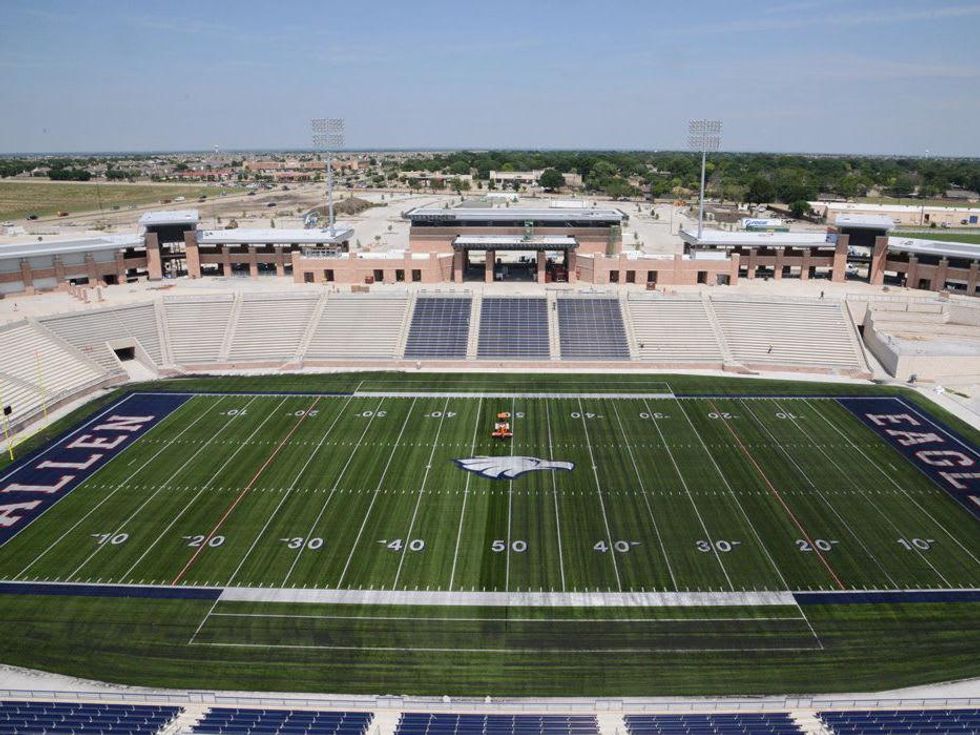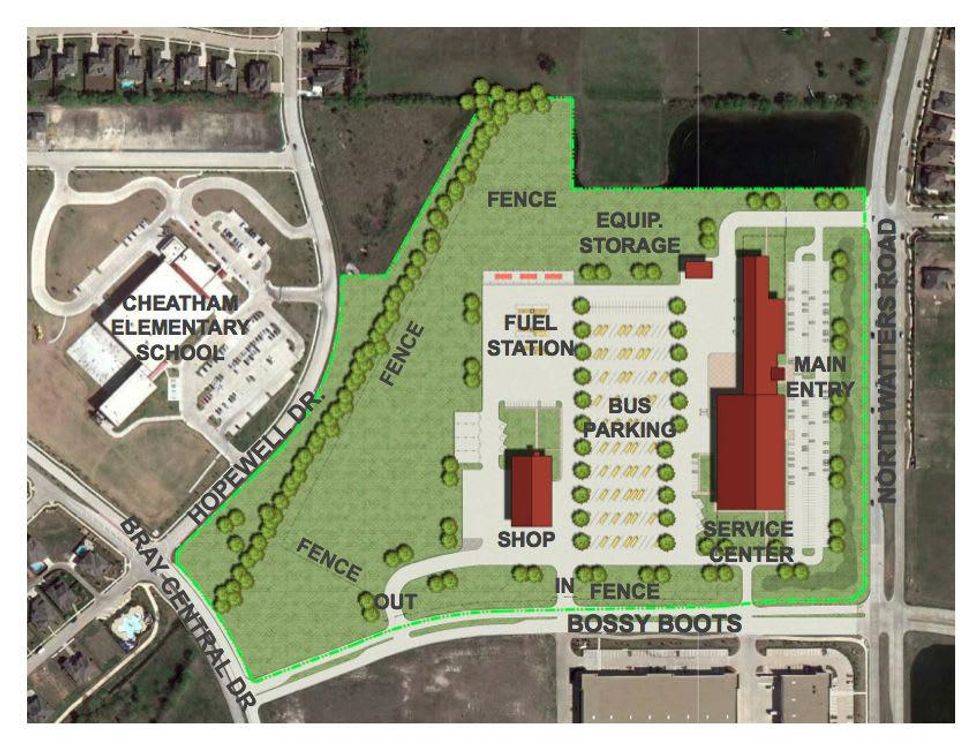Ongoing Controversies
Allen bus barn project keeps rolling despite community outcry
Allen ISD’s transportation service center has been called a lot of names since it was brought to life as part of a 2009 bond election. With a nearly $37 million price tag, it’s been labeled the Taj Mahal of Bus Barns by detractors, who are none too pleased with the idea of 130 buses and 25,000 gallons of gasoline located 1,000 feet away from Cheatham Elementary School.
Allen ISD spokesman Tim Carroll prefers that it’s simply called a service center. (It will also house the district’s food service department.)
Voters easily approved the facility, along with the district’s famous $60 million football stadium, as part of a $119 million bond package.
Some residents liken the bus barn’s fuel storage component to the West fertilizer plant. “It’s fertilizer versus fuel, but an explosion is an explosion,” says Jennibeth Brackett.
“When our government is faced with wanting to pass something that it knows will be unpopular, they don’t publicize it very much,” says Allen resident Suzanne White. “I equate this to what happened with the Monsanto bill.”
Passed in March, the Monsanto Protection Act allows genetically modified crops to be planted without a safety review.
The analogies of outrage don’t end there, however.
Another Allen resident, Jennibeth Brackett, likens the bus barn’s fuel storage component to the fertilizer plant in West, Texas.
“It’s fertilizer versus fuel, but an explosion is an explosion,” Brackett says. “I would hope that it would reignite some concerns and willingness to reevaulate what they are doing.”
What they are doing is moving forward with plans to replace the current bus service center, which was built in 1982 for a school district with 5,000 students. There are currently 20,000 students in Allen ISD.
A long and winding road
Construction on the new service center is slated to begin this summer, but it’s been a pot-hole-filled road every step of the way. Carroll expressed exasperation over the wide variety of bus barn conspiracy theories.
“Folks are looking at other things that have happened and trying to connect it to us,” Carroll says. “We are confident that the facility will meet or exceed every local, state and federal guideline that’s required.”
“We are confident that the facility will meet or exceed every local, state and federal guideline that’s required,” says AISD spokesman Tim Carroll.
In an effort to assuage resident fears, Allen ISD contracted independent consultants to conduct environmental impact studies on the proposed Watters Road site. The studies, which covered traffic, air and water quality, found the addition of a bus barn would not have a significant impact on the area.
“We spent thousands if not tens of thousands of dollars on independent studies,” Carroll says. “When the studies showed there was little to no risk, then they came back and said ‘We don’t believe you.’ At some point we have to stop responding to every single request.”
When voters approved the service center in 2009, a location had yet not been identified. Shortly after the election, Allen ISD purchased a 55-acre parcel of land for $1.9 million on Malone Road. But the district would abandon those plans in 2011 and instead purchase 39 acres of land on Watters Road for the service center.
Why the district changed course is under dispute. Carroll says it was because “another property became available.” But others point to the fact that at the time of the land purchase, an AISD board member lived across the street from the owner of the Watters Road property — Briar Ridge's vice president, Charles Nies.
Residents collected 500 signatures against the Malone Road facility, but Carroll says that had no bearing on the decision to find a new location. Stopthebarn.org would eventually amass more than 1,000 signatures against the Watters Road property but inspire no action. The site has since become largely defunct.
Costing $3 million more than the Malone Road site, the Watters Road property was sold to the school district for a combination of cash and credit, because of a $300,000 debt that Briar Ridge Investments owed AISD. Debts and pollution aside, the issue that’s gaining the most traction among Allen residents lately is decreased property values and wasteful spending.
“People don’t want to live next to this thing,” says White, who is considering moving to Richardson or North Oak Cliff if the bus barn project is completed as planned.
Brackett laments the fact that students recently held a penny drive to raise money for a new library at Lindsey Elementary.
“The service center employees have a Cadillac facility, and the children have a library with books purchased by money they’ve gleaned from their piggy banks and couch cushions?” she exclaims. “This is nuts!”
However maddening, Carroll says the nearly $37 million earmarked for the service center can’t be funneled anywhere else due to the constraints of the bond election.
While it might be too late to stop the bus barn, Allen voters do have a chance to make changes for the future with a new election. Two school board positions, places 4 and 5, are up for election on May 11.
“We put them in these positions to be our voice, and they aren’t hearing us,” White says. “I’m very discouraged.”
---
Transportation Service Center Timeline
May 2009: Voters approve a $36.5 million bus service center as part of a $119 million bond election. Allen ISD purchases 55 acres on Malone Road for $1.9 million to house the service center.
July 2011: More than 500 signatures are collected against the Malone Road facility, and Allen ISD agrees to look at other potential locations.
August 2011: Allen ISD purchases 39 acres on Watters Road for $4.9 million.
September 2011: Stopthebarn.org launches a grass roots campaign against the Watters Road location, gathering more than 1,000 signatures against the project.
April 2012: Allen ISD presents findings from a series of environmental impact studies on the Watters Road property. Independent consultants say that if all established EPA standards are adhered to, the facility would have minimal impact on water, traffic and air quality.
June-September 2012: Allen ISD works with PBK architects to develop the schematic design of the service center.
May 2013: School board elections for places 4 and 5.
Summer 2013: Construction on the transportation service center begins.
Fall 2014: Estimated completion of the project.
Source: CultureMap research and Allen ISD
In addition to space for 130 buses, the new Allen service center will contain a maintenance shop and fueling station with around 25,000 gallons of fuel.



